Sappada's traditional architecture comprises two distinct types of buildings: the house (Haus or Hìlzahaus) and the stable/hay-loft complex (¦tol). The two entities can exist separately or can, in certain cases, be adjacent and interconnected.
Almost all the buildings are made of horizontal wooden beams, laid on a masonry base and joined together at the building's corners.
Usually, the façades of the buildings stand facing south, along the sunny side of the valley.
The traditional Sappada house, in his basic form, has a rectangular floor plan (m 10 x 9) and two stories rising from a masonry base which sits on the ground. Counting the attic, the house has 4 levels:
1 - The masonry foundation (ciòkl - 'zoccolo') encloses a basement which contains a cellar (kèlld(e)r) and a laundry room (boschkùchl). The cellar is usually connected with the floor above.
The layout of the rooms on the first and second floor is determined by the position of the cross-sectional corridor (labe):
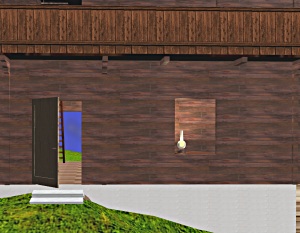
2 - The first floor is accessible from the lawn through a lateral door (tòur) that leads into a corridor; this, generally ends on the opposite side with another door. On the first floor there are the living room (khò¨tibe) and the kitchen (kùchl). The first is characterized by the large vaulted masonry oven-stove (óuvn), which was supplied with fuel through a special opening in the corridor (óuvnlòch). The kitchen (kùchl) is characterized instead by the fireplace (hièrt, o óffnsvàir) and the poles, parallel to the ceiling, to which people hung the food when the room was used as a smoke room (èisn). In the 4-room-plan houses, opposite to the corridor on the North side there are two smaller rooms: a small store room (¨tìbile) and a pantry (kèllderle). From the corridor, a stairway (¨tìege) leads to the upper floor.
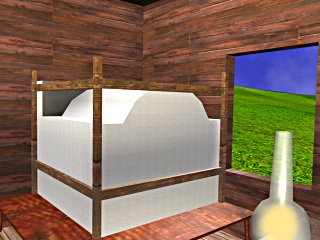
3 - The second floor has the same layout of the first, with a corridor, two bedrooms (kòmm(e)rn) and, in the 4-room-plan houses, two smaller rooms (kèmmerlan). At this level, a balcony (sóld(e)r) runs around three sides of the house and leads, at one end, to the toilet (gònck). A lateral portion of the balcony (generally on the South-Western corner) is often enclosed by boards so that an additional small room (géd(e)nle) can be obtained. Often, the side part of the balcony is suppressed and the only part of it that is left is that corresponding to the opening of the corridor's door. Another internal stairway leads to the attic.
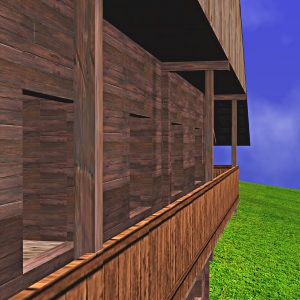
4 - The attic (kómm(e)rdìlle) protrudes on the front and the back; sometimes, a part of it was enclosed to form a small store room (gódn). The two-pitch roof (doch) is covered with shingles and is supported by rafters kept together by big wooden pins. A vertical plank siding encloses the front and the back sides of the attic not covered by the roof pitches. On such siding there is a small opening (or, sometimes, one or more decorative fretwork openings), to let the sunlight into the attic. The two wooden gutters (rìngl), which run along the two pitches of the roof, are carved out of small-size tree trunks.
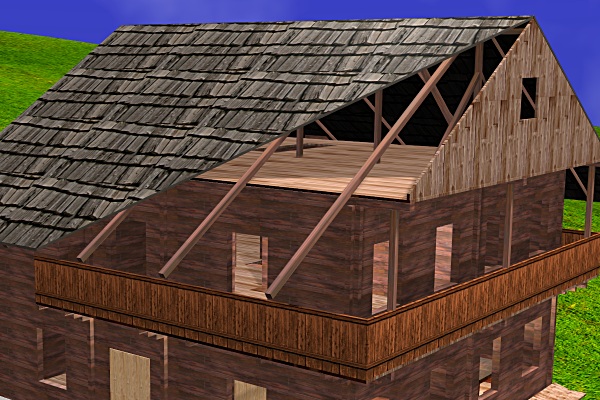
The windows, originally small to minimize heat losses, in recent times have been often widened to improve the rooms brightness. Originally, the heating of the house depended entirely on the vaulted masonry oven-stove and on the kitchen fireplace. The rooms upstairs were heated by the hot air rising from the first floor.
Some of the houses have a siding made of wooden shingles cut in the shape of round scales; a decorative solution (useful also as a protection for the beams) which was presumably introduced in the first quarter of the 19th century.
Often, a single house was conceived for a two-family use; in such a case, the partition of the rooms was symmetrical with respect to an imaginary axis corresponding to the roof-ridge. The cross-sectional corridor was communal. The search for multi-family dwellings has led, in a few rare cases, to the development of three-story houses.
Some unusual 19th century variations of the traditional house plan have the cross-sectional corridor running perpendicular to the façade. As a consequence, the entrance door is located in the front and the rooms are aligned along the sides making the two-family partition more noticeable and practical.
Virtually all the existing traditional buildings of Sappada have undergone some renovations and transformations so that none of them fully reflects the pure, basic and unaltered structure of the Sappada's house. In many cases, the houses were expanded along the sides. At times, such expansions were as sizeable as to double the surface and the volume of the house. Some other times, the additions were so substantial that the original prospect and structure of the house was lost forever.
The analysis of the structures and the floor plans of the houses, in relation to the variable position of the cross-sectional corridor, has led us to establish the following classification of house types:
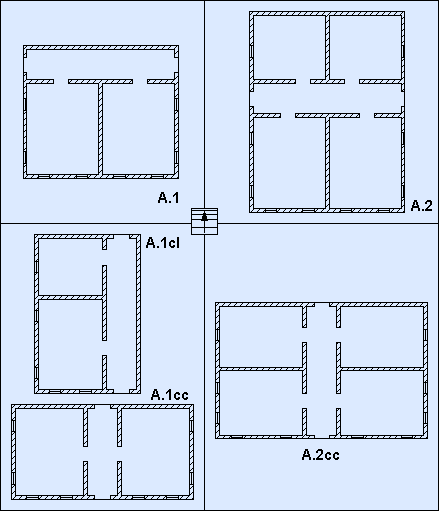
- A.1 SINGLE MODULE - 2-ROOM FLOOR PLAN
- A.1 corridor along the Northern wall
- A.1cl lateral corridor (along a perimetrical wall)
- A.1cc central corridor (dividing the two rooms)
- A.2 DOUBLE MODULE - 4-ROOM FLOOR PLAN
- A.2 transversal cross-sectional corridor (from side to side)
- A.2cc longitudinal central cross-sectional corridor (orthogonal to the façade)
- A.23p cross-sectional corridor, 3-story building
- A.2-El(E) cross-sectional corridor, lateral expansion (on the East side)
- A.2-Ell(W/E) cross-sectional corridor, double lateral expansions (on the West & East sides)
- A.3 composite floor plan, resulting from extensive developments
- A.4 mostly masonry houses - small wooden parts built in traditional shapes
The stable/hay-loft complex (¦tol) has two levels, one used as stable (¦tol) and one used as hay-loft (Dìlle).
- The ground floor, built mostly with masonry material (except in rare, ancient cases in which it is made of horizontal wooden beams), corresponds to the basement of the houses. It accommodates the stable with its bedsteads and mangers and, sometimes, a plank fence for the pig.
- An external stairway (dìll(e)n¨tìege) leads to the balcony of the hay-loft, located on the upper floor. The hay-loft is also accessible from a large back door (dìllntir) connected to the ground by a ramp ending in a small bridge (prùcke). Along the balcony (pirl), some horizontal poles were used as drying racks for the cereals. A deck (schìesse) located under the roof is used for the storage of hay (grùimat). The hay-loft is also used as storage for the numerous agricultural tools and for the poles of the sheaves.
Not far from the stable/hay-loft one could find the traditional kèisn, a drying rack for cereals made of parallel horizontal sticks running between two tall vertical poles stuck on the ground. Only two of these structures are still standing.
During the 20th century the stable/hay-lofts, originally made of massive wooden beams like the houses, were built instead with a combination of masonry (natural stone pillars at the 4 corners) and wooden elements (wooden planks covering the sides of the building). In the most recent examples, the natural stone has been substituted by bricks.
With these subsequent stages of the building technique in mind, we have devised a 3-'generation' classification for the stable/hay-lofts as follows:
- B.1 1st generation stable/hay-lofts - built with horizontal wooden beams sitting on a masonry foundation.
- B.2 2nd generation stable/hay-lofts - built with a combination of natural stone (for the foundation and corner load-bearing structures) and wooden planks (for the siding).
- B.3 3rd generation stable/hay-lofts - built using significant amounts of bricks for the foundation and the corner load-bearing structures.
The cases in which the stable/hay-loft is attached to the house can be expressed joining, with an appropriate symbol, the alphanumeric terms of the type classes in one single formula:
ex.: A.2-El(W)^B.1